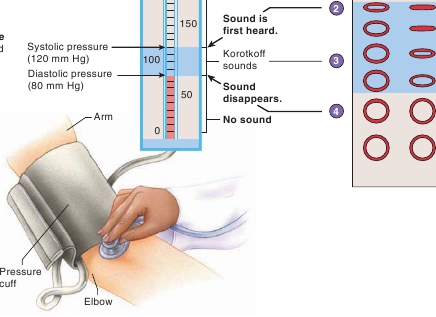
enough to keep the brachialartery closed, no blood flowsthrough it, and no sound isheard.
2
When cuff pressure decreasesand is no longer able to keepthe brachial artery closed, bloodis pushed through the partiallyopened brachial artery,producing turbulent blood flowand a sound.
Systolic pressure
is the pressure at which a soundis first heard.
3
As cuff pressure continues todecrease, the brachial arteryopens even more duringsystole. At first, the artery isclosed during diastole, but ascuff pressure continues todecrease, the brachial arterypartially opens during diastole.Turbulent blood flow duringsystole produces Korotkoffsounds, although the pitch ofthe sounds changes as theartery becomes more open.
4
Eventually, cuff pressuredecreases below thepressure in the brachialartery, and it remains openduring systole and diastole.Nonturbulent flow isreestablished, and nosounds are heard.
Diastolicpressure
is the pressure atwhich the sound disappears.
300
250
No sound
1
brachial artery isopen during:
Systole Diastole
200
Blocked

Blocked orpartiallyopen
Open
PROCESS FIGURE 21.32
Blood Pressure Measurement
calculation of flow. Specifically, a small change in the diameter ofa vessel dramatically changes the resistance to flow, and thereforethe amount of blood that flows through it. For example, decreasingthe diameter of a vessel by half increases the resistance to flow16-fold and decreases flow 16-fold. Vasoconstriction decreasesthe diameter of a vessel, increases resistance to flow, anddecreases blood flow through the vessel. Vasodilation increasesthe diameter of a vessel, decreases resistance to flow, andincreases blood flow through the vessel.Changes in blood pressure and blood vessel diameter producethe major changes in blood flow through blood vessels. Duringexercise, heart rate and stroke volume increase, causing bloodpressure in the aorta to increase. In addition, blood vessels in skeletalmuscles vasodilate, and resistance to flow decreases. As a conse-quence, a dramatic increase in blood flow through blood vesselsin exercising skeletal muscles occurs.
Viscosity
(vis-kos′i-t ē ) is a measure of a liquid’s resistance toflow. As the viscosity of a liquid increases, the pressure requiredto force it to flow also increases. The viscosity of liquids is
commonly determined by considering the viscosity of distilledwater as 1 and then comparing the viscosity of other liquids withthat. Using this procedure, whole blood has a viscosity of 3.0–4.5,which means that about three times as much pressure is requiredto force whole blood through a given tube at the same rate as forc-ing water through the same tube.The viscosity of blood is influenced largely by
hematocrit
(h ē ′m ă -t ō -krit, hem′ ă -t ō -krit), which is the percentage of thetotal blood volume composed of red blood cells (see chapter 19).As the hematocrit increases, the viscosity of blood increaseslogarithmically. Blood with a hematocrit of 45% has a viscosityabout three times that of water, whereas blood with a very highhematocrit of 65% has a viscosity about seven to eight times thatof water. The plasma proteins have only a minor effect on theviscosity of blood, but dehydration or uncontrolled production ofred blood cells can increase the hematocrit and the viscosity ofblood substantially. Viscosity above the normal range increasesthe workload on the heart. If this workload is great enough, heartfailure can result. 751